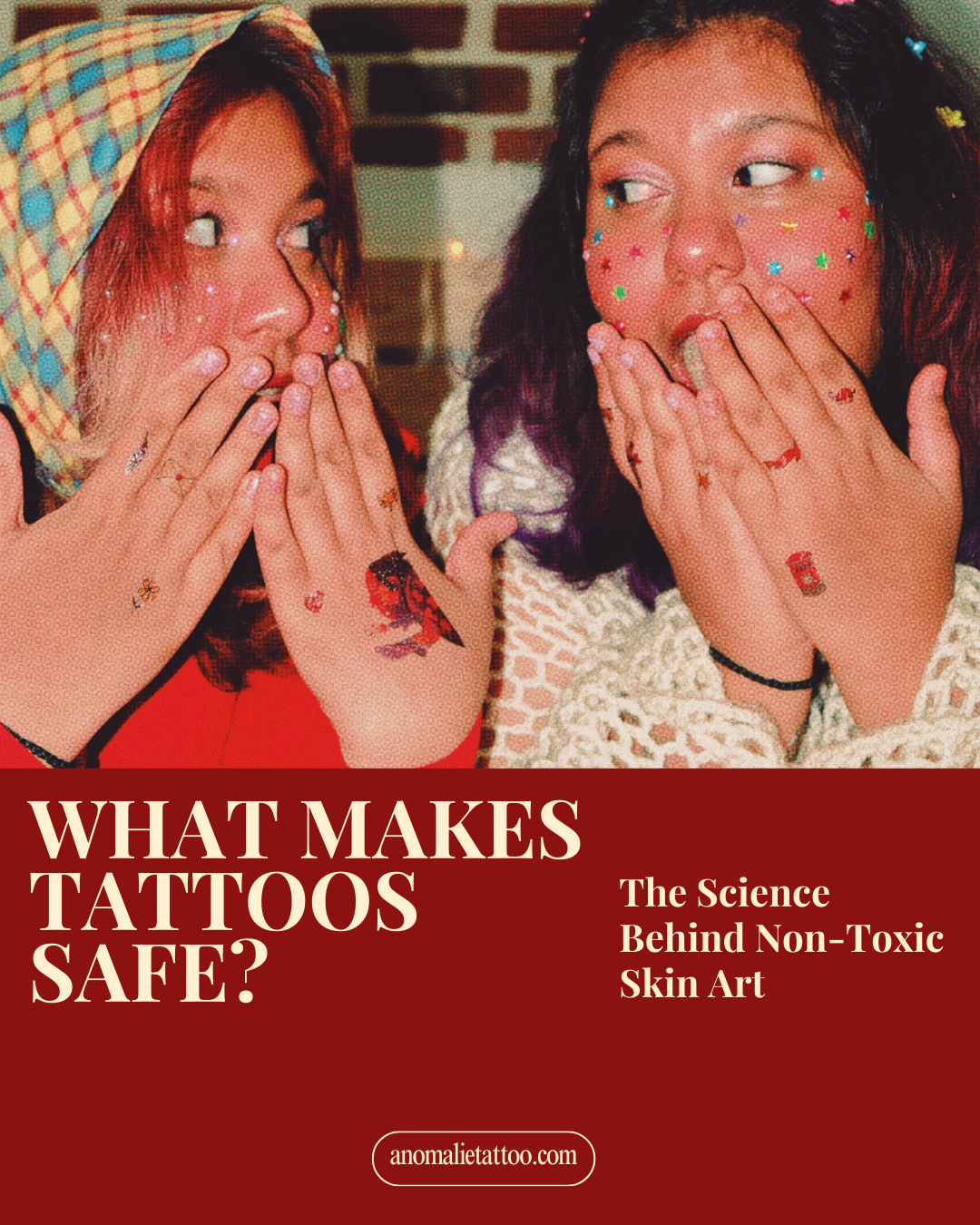Temporary tattoos are fun, fashionable, and increasingly popular at kids’ parties, weddings, and festivals. But for many parents and conscious buyers, one question lingers: are they actually safe for the skin?
At Anomalie Tattoo Co., safety is at the heart of what we do. We believe body art should always be worry-free, which is why we only use non-toxic, cosmetic-grade materials. But what does “non-toxic” really mean, and how can you be sure the tattoos you’re buying are safe? Let’s dive into the science.

🧪 What Makes a Temporary Tattoo Non-Toxic?
When a product is labelled non-toxic, it means it does not contain harmful chemicals that could damage the skin or body. For temporary tattoos, this involves three key components:
- Inks & pigments: Should be cosmetic-grade, approved for skin contact, and free from heavy metals or industrial dyes.
- Adhesive layer: The film that transfers the design should be gentle, hypoallergenic, and latex-free.
- Paper backing: Must comply with safety standards to ensure no harmful residues transfer during application.
All of these elements need to meet safety guidelines for children’s products and cosmetics. At Anomalie, our tattoos comply with EN71 (European toy safety) and ASTM F963 (US safety standards), giving parents peace of mind.
🔬 Safety Standards Explained
So what do these acronyms really mean? Here’s a breakdown:
- EN71-3: Tests for harmful substances like lead, cadmium, and other heavy metals in children’s products.
- ASTM F963: A US standard that covers both mechanical and chemical safety for toys and accessories.
- CPSIA (Consumer Product Safety Improvement Act): Limits phthalates and lead in items intended for children.
By meeting these standards, our tattoos prove they are as safe as children’s toys and suitable for sensitive skin.
⚠️ Why “Cheap Tattoos” Can Be Risky
Not all temporary tattoos on the market are created equal. Many cheap versions sold at fairs or tourist spots do not go through safety testing. These can contain unsafe dyes, unregulated adhesives, or even PPD (p-phenylenediamine), the chemical found in black henna that can trigger severe allergic reactions.
Dermatologists warn that exposure to PPD can lead to blistering, scarring, and even permanent allergies to hair dye. That’s why it’s crucial to avoid tattoos that don’t disclose ingredients or carry safety certifications.
👩👧 Why Parents Should Care About Non-Toxic Tattoos
Children’s skin is thinner and more sensitive than adults’, which makes safety even more important. A tattoo that might not bother an adult could cause rashes or irritation in a child.
That’s why we created the Kids Tattoos Collection, designed specifically for safe use by children. Parents can relax knowing every sheet is non-toxic, clean, and dermatologist-approved in design.

🌿 The Clean Beauty Connection
The rise of clean beauty has changed how we view personal care. Just as you wouldn’t put an unsafe cream or lotion on your skin, the same logic applies to temporary tattoos. Non-toxic tattoos align with the clean beauty philosophy by:
- Using safe, transparent ingredients.
- Avoiding harmful chemicals and allergens.
- Respecting the skin barrier with gentle adhesives.
- Committing to eco-friendly packaging wherever possible.
Our Best Sellers prove that safety and style can go hand in hand.
📊 The Science of Application & Removal
Applying a tattoo is simple: press with water and wait a few seconds. But what’s happening on a microscopic level?
- The water activates the adhesive layer, helping the pigment transfer to your skin.
- The pigments sit on the top layer of skin (the epidermis) — they don’t penetrate deeper like permanent tattoos.
- Over a few days, as your skin naturally exfoliates, the tattoo fades away.
Removal is just as safe. A little coconut oil or baby oil dissolves the adhesive, making the tattoo easy to wipe off without scrubbing. This ensures no damage to the skin barrier.
✨ How to Tell If a Tattoo Is Truly Safe
When shopping for temporary tattoos, use this quick checklist:
- Does the brand mention safety standards like EN71 or ASTM?
- Are the ingredients transparent and cosmetic-grade?
- Is the product marketed as non-toxic or safe for kids?
- Is the brand trusted and reviewed by parents or conscious buyers?
If the answer is no, it’s best to avoid them.
🌟 Why Choose Anomalie Tattoos?
At Anomalie Tattoo Co., we take the science seriously — but we also make it fun. Here’s why families and event planners across India trust us:
- Non-toxic, tested designs safe for both kids and adults.
- Artist collaborations that bring culture and creativity to every sheet.
- Collections for every occasion — from weddings and festivals to kids’ birthdays.
- Clean beauty ethos that values transparency and safety at every step.

💌 Final Takeaway
The science is clear: non-toxic tattoos are safe, fun, and skin-friendly when made with cosmetic-grade materials and tested to international standards. The key is knowing what to look for — and choosing brands that prioritise safety as much as design.
Want to try non-toxic tattoos for yourself? Explore Anomalie’s Best Sellers and discover how safe, stylish, and science-backed temporary tattoos can be.
